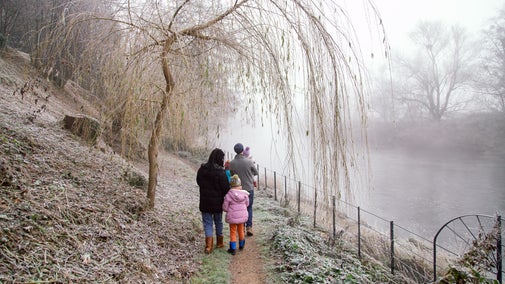Buscot Red Walk
Oxfordshire, Buckinghamshire & Berkshire
Discover Buscot village and the surrounding countryside on this circular riverside walk. One of the prettiest stretches of the 180-mile Thames Path, it's an easygoing route that mixes bucolic scenery with plenty of historical titbits. Follow it round to find the smallest lock currently on the River Thames at Buscot Weir, two Second World War bunkers and the remarkable remnants of a Victorian-era industrial farm.
Near to
Buscot and Coleshill EstatesStart point
Buscot Village National Trust car park, grid ref: SU23098Trail information
*A largely flat riverside walk with some gentle slopes in the latter stages. For further details, please see Terrain section.
**Access difficult due to uneven ground, narrow paths in places, and gated areas. For further details, please see section marked Access.
***Dogs welcome. For further details, please see section marked Facilities.
Get in touch
Our partners

We’ve partnered with Cotswold Outdoor to help everyone make the most of their time outdoors in the places we care for.
You might also be interested in
Walking
Explore some of the finest landscapes in our care on coastal paths, accessible trails, woodland walks and everything in between. Find the best places to walk near you.

Things to do at the Buscot and Coleshill Estates
Walk farm tracks and landscaped parkland, picnic by tranquil sections of the Thames, admire historic house Buscot Park and discover a watermill and wartime secrets in Coleshill.

Eating and shopping at the Buscot and Coleshill Estates
The two estates and their villages offer convenient spots for refreshments, lunch or cream teas, a cosy country pub and a smattering of local shops.

Staying safe at National Trust places
The special places in National Trust care sometimes come with a few risks for visitors, be it coastline or countryside. Find out how to keep safe throughout your visits.

Follow the Countryside Code
Help to look after National Trust places by observing a few simple guidelines during your visit and following the Countryside Code.

Cotswold Outdoor: our exclusive walking partner
Learn about the National Trust’s ongoing partnership with Cotswold Outdoor. Find out how they help us care for precious places and the exclusive discount available for National Trust supporters.

Walking in Oxfordshire, Buckinghamshire and Berkshire
From gentle strolls for little legs to longer hikes through the rolling Chiltern hills, these are some of the best walks in Oxfordshire, Buckinghamshire and Berkshire.


